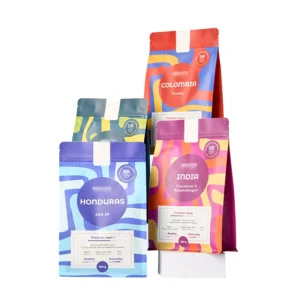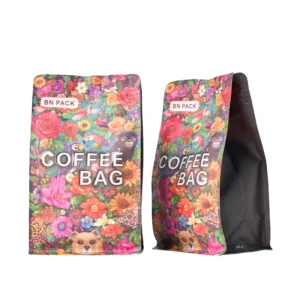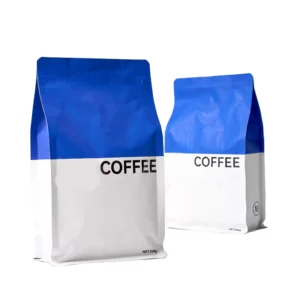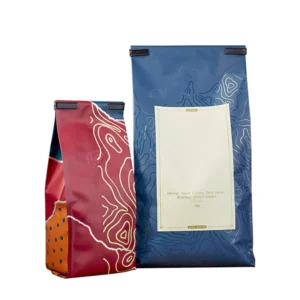How coffee packaging impacts flavor and freshness is crucial for delivering a premium experience. Proper packaging protects your coffee from oxygen, moisture, and light—preserving its rich taste and aroma. Without it, your coffee can lose its freshness quickly, affecting flavor. At BN Pack, we provide packaging solutions that keep your coffee fresh for longer.
Ready to elevate your coffee’s quality? Quote your packaging needs with us today!
The Importance of Coffee Packaging
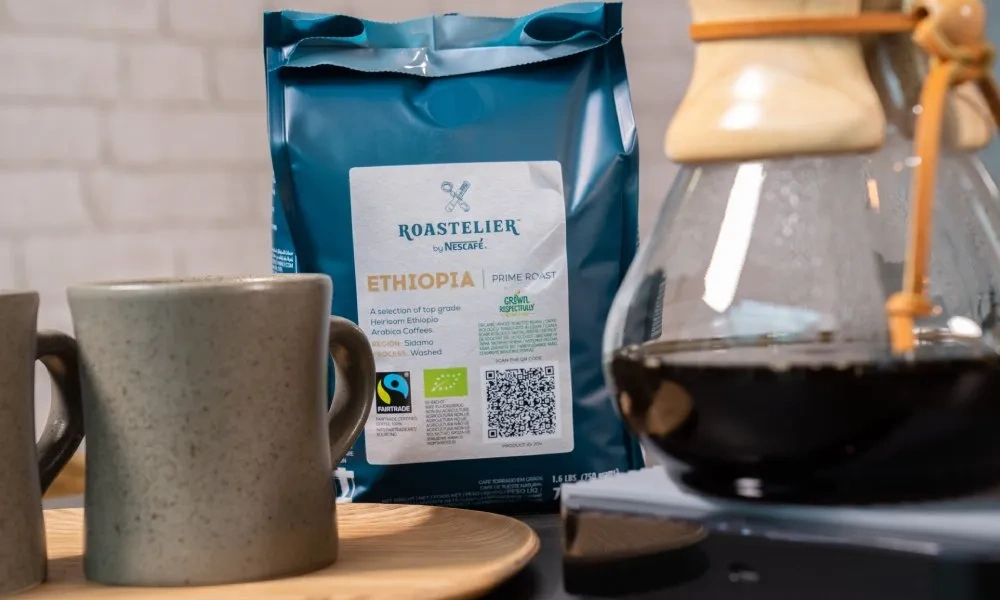
Coffee is a delicate product. After roasting, coffee beans and grounds release oils and aromatic compounds that define their unique flavor and fragrance. However, these compounds are sensitive and break down when exposed to air, light, and moisture. Without proper packaging, your coffee can quickly lose its freshness, resulting in a bland, lackluster brew.
At BN Pack, we know that delivering the best coffee goes beyond sourcing premium beans—it’s about preserving their quality all the way to your cup.
Does Packaging Affect Coffee Freshness?

Packaging is crucial for maintaining the freshness of your coffee. Once coffee beans are roasted, they release aromatic oils and gases that define their flavor. Without the right packaging, exposure to oxygen, moisture, and light can quickly cause these compounds to degrade, leaving you with stale coffee. Proper packaging helps protect these essential elements, keeping your coffee fresh and flavorful for a longer time.
Effective coffee packaging also plays a key role in preserving the taste and aroma of your beans. Features like airtight seals and one-way valves ensure that your coffee stays protected from harmful elements. Choosing high-quality, protective packaging, you ensure that your coffee remains at its peak freshness, ready to deliver a perfect cup every time.
What Makes Coffee Flavorful?
Coffee’s flavor is a result of a delicate balance of oils, acids, and over 800 aromatic compounds. These components are highly sensitive to environmental factors. Oxidation, where oxygen interacts with these compounds, is a primary cause of flavor loss. Additionally, moisture can lead to staleness, while light can cause photodegradation, altering the coffee’s taste profile.
How Does Packaging Protect Coffee?
Effective coffee packaging is essential for maintaining the quality and freshness of your coffee. It acts as a barrier against several external factors that can degrade flavor and aroma. Here’s how the right packaging keeps your coffee at its best:
Oxygen: Airtight seals are crucial in preventing oxidation. Oxygen interacts with the aromatic compounds in coffee, leading to flavor loss. By blocking oxygen, the coffee’s rich flavors and freshness are preserved for longer.
Moisture: Barrier layers within the packaging act as a shield, keeping moisture away. Exposure to humidity can lead to staleness and mold growth, compromising the coffee’s taste. Moisture-resistant packaging ensures your coffee stays dry and flavorful.
Light: Coffee is highly sensitive to light, especially UV rays. Exposure to light can cause photodegradation, altering the coffee’s delicate flavor profile. Opaque materials, like dark or foil-lined bags, effectively block harmful UV light, ensuring your coffee stays fresh and aromatic.
Temperature Fluctuations: Coffee’s freshness is also affected by temperature changes. Insulating materials in packaging help to stabilize the environment around the coffee, preventing extreme heat or cold from causing any flavor degradation or compromising the beans’ integrity.
The right packaging is crucial to preserving the coffee’s taste and aroma. By safeguarding against oxygen, moisture, light, and temperature fluctuations, high-quality packaging ensures your coffee reaches you at its freshest.
Key Features of Effective Coffee Packaging
One-Way Valve
One-way valve is a key feature that allows your coffee to stay fresh longer. It lets gases released by freshly roasted beans escape while preventing air from entering the bag. This helps maintain the coffee’s flavor and aroma without causing the bag to burst. With this valve, your coffee stays sealed in its best form, preserving its peak taste from roasting to your cup.
Interior Lining: Foil vs. Biodegradable
Foil
Foil is a highly effective material for preserving coffee’s freshness. It provides a strong barrier against moisture, oxygen, and light—three major factors that degrade coffee’s flavor and aroma.
The reflective properties of foil protect the beans from UV rays, while its air-tight seal prevents oxidation, ensuring your coffee stays fresh for an extended period. It’s a go-to choice for high-quality coffee packaging that prioritizes freshness.
Biodegradable Lining:
Biodegradable linings offer a sustainable alternative while still preserving the freshness of your coffee. Made from renewable resources, these linings are designed to break down naturally, reducing environmental impact.
Biodegradable Linings may not be as moisture- and oxygen-resistant as foil, advancements in biodegradable materials have improved their ability to maintain coffee’s quality, making them an eco-conscious choice for sustainable coffee packaging.
How Coffee Packaging Impacts Flavor and Freshness?

Vacuum-Sealed Coffee Bags
Vacuum-sealed coffee bags are one of the most effective ways to preserve coffee’s freshness. The process removes air from the bag, creating a vacuum that helps protect the beans from oxygen, moisture, and other environmental factors. This packaging method is widely used in both retail and wholesale coffee sales, as it significantly extends shelf life.
Pros: Vacuum-sealed bags provide excellent protection for your coffee by keeping air, moisture, and light out. This ensures your coffee stays fresh, preserving its rich flavors and aromas. The airtight seal prevents oxidation, which helps maintain the full-bodied taste of your coffee. Additionally, vacuum-sealed bags are compact, easy to store, and often reduce packaging waste.
Cons: Vacuum-sealed bags are great at preserving freshness, they can be less eco-friendly than other options. The materials used to create the vacuum seal may not always be biodegradable, contributing to environmental waste. Additionally, the process can sometimes cause the coffee beans to compress, which may affect the texture or appearance of the beans.
One-Way Valve Coffee Bags
One-way valve coffee bags are designed to preserve the freshness of your coffee while allowing it to breathe. These bags feature a one-way valve that lets gases from freshly roasted coffee escape without letting air back in. This helps maintain the coffee’s aroma and flavor, ensuring a fresh cup every time.
Pros: The one-way valve prevents the buildup of excess pressure inside the bag, which can occur when gases from roasted coffee are trapped. It allows the coffee to release these gases without introducing oxygen, moisture, or contaminants.
This means the coffee stays fresh and flavorful longer. The bags are often made with eco-friendly materials, offering a balance between freshness and sustainability.
Cons: The one-way valve works well to preserve coffee, these bags are not completely airtight. The valve allows gases to escape, but air can still enter the bag through other openings. This can lead to some degree of flavor loss over time. The bags may not protect as well against light exposure, which can impact the coffee’s freshness in some environments.
Airtight Containers
Airtight containers are a popular choice for storing coffee at home or in cafes. These containers completely seal out air, moisture, and light, providing a secure environment for your coffee.
Pros: The primary benefit of airtight containers is their ability to prevent oxygen from entering, which helps preserve the freshness of your coffee for a longer period. With no air exposure, your coffee’s rich flavors and aromas are kept intact. Airtight containers are reusable, making them a more eco-friendly option compared to single-use packaging.
Cons: Airtight containers are great for storage, they don’t always allow for the release of gases that come from freshly roasted coffee. Without a one-way valve, the buildup of pressure inside the container can affect the beans’ texture and freshness. They are less portable than vacuum-sealed bags, which can be a disadvantage for on-the-go coffee lovers.
Innovative Packaging Technologies
Nitrogen-Flushed Coffee Packaging
Nitrogen-flushed coffee packaging is an innovative method designed to keep your coffee fresh. In this process, nitrogen gas is pumped into the bag before sealing, replacing the oxygen that could cause oxidation. The nitrogen helps to protect the coffee from moisture, air, and light, maintaining its flavor and aroma for a longer period.
Advantage: The main advantage of nitrogen-flushed packaging is its ability to preserve the coffee’s freshness without the need for chemical preservatives. Displacing oxygen with nitrogen, it prevents oxidation and helps keep the coffee’s rich taste and aroma intact.
This method extends the shelf life significantly while maintaining the coffee’s high-quality flavor, making it a great choice for premium coffees.
Eco-Friendly Coffee Packaging
Eco-friendly coffee packaging focuses on using sustainable materials to protect your coffee while minimizing environmental impact. This packaging option is made from biodegradable, recyclable, or compostable materials, offering a greener alternative to traditional packaging methods. It ensures that your coffee stays fresh without contributing to waste and pollution
Advantage: The primary advantage of eco-friendly coffee packaging is its minimal environmental footprint. Choosing biodegradable or recyclable materials, you help reduce plastic waste and contribute to a more sustainable future.
This type of packaging still provides effective protection against air, moisture, and light, preserving your coffee’s freshness while supporting eco-conscious practices.
Environmental Impact of Coffee Packaging
Traditional coffee packaging typically uses plastics and aluminum, which can be challenging to recycle. Sustainable alternatives help reduce waste and cater to eco-conscious consumers looking for greener options.
BN Pack’s Commitment to Sustainability
At BN Pack, we take pride in offering packaging solutions that combine freshness with environmental responsibility, ensuring your coffee experience aligns with your sustainability values.
Coffee Packaging That Reduces Environmental Impact
Recommended Coffee Packaging
-
Biodegradable Stand Up Coffee Pouches With Zipper
-
Black Kraft Paper Coffee Pouches
-
Custom Drip Coffee Pouches
-
Custom Printed Flat Bottom Coffee Bag
-
Custom Recyclable Flat Bottom Coffee Bags
-
Flat Bottom Coffee Bag With Pocket Zipper
-
Eco Friendly Coffee Pouch
-
Foil Lined Side Gusset Coffee Packaging Bag
-
Kraft Paper Flat Bottom Coffee Pouch
As consumer awareness of environmental issues grows, the coffee industry is increasingly focused on sustainable packaging solutions. Reducing the environmental impact of coffee packaging involves using materials and designs that minimize waste, conserve resources, and promote recyclability or biodegradability.
Biodegradable Coffee Packaging
Biodegradable coffee packaging offers a promising alternative to traditional plastic and foil-lined bags. These packaging solutions are designed to break down naturally in composting environments, reducing landfill waste and minimizing environmental impact. Materials like polylactic acid (PLA) derived from corn starch or other plant-based sources are used to create biodegradable coffee bags. These materials decompose into natural elements, contributing to a circular economy.
However, it’s crucial to ensure that biodegradable coffee packaging is certified compostable and disposed of in appropriate composting facilities. Not all biodegradable materials decompose effectively in home composting setups, and some may require industrial composting conditions. Proper labeling and consumer education are essential for maximizing the environmental benefits of these packaging solutions.
Recyclable Coffee Packaging
Recyclable coffee packaging focuses on using materials that can be processed and reused, reducing the need for virgin resources. Materials like mono-material plastics or paper-based laminates are designed for easy recycling, allowing them to be incorporated into new products. Recyclable coffee bags often feature clear labeling and instructions to guide consumers on proper disposal.
Implementing effective recycling infrastructure is crucial for the success of recyclable coffee packaging. Ensuring that these materials are collected, sorted, and processed correctly minimizes contamination and maximizes the recovery of valuable resources. Collaboration between packaging manufacturers, coffee roasters, and recycling facilities is essential for establishing a robust and efficient recycling system.
Reduced Material and Lightweight Packaging
Minimizing the amount of material used in coffee packaging is another effective strategy for reducing environmental impact. Lightweight packaging designs, such as thinner films or flexible pouches, require fewer resources and generate less waste. These designs also reduce transportation costs and carbon emissions, contributing to a smaller environmental footprint.
However, it’s essential to balance material reduction with product protection. Ensuring that lightweight coffee bags provide adequate barrier properties and structural integrity is crucial for maintaining coffee freshness and quality. Innovations in material science and packaging design enable the development of high-performance, low-impact packaging solutions.
How to Choose the Best Coffee Packaging?
Choosing the right packaging is crucial for keeping your coffee fresh and flavorful. Here are some essential tips to help you select the best packaging for your coffee:
One-way valve bags: Ideal for freshly roasted coffee, these bags allow gases to escape while keeping oxygen out, preserving flavor.
Airtight containers: Perfect for long-term storage, airtight containers maintain the freshness of your coffee by sealing out air and moisture.
Sustainable options: If reducing your environmental footprint is important to you, look for eco-friendly packaging alternatives.
Packaging that extends shelf life: Choose nitrogen-flushed bags or vacuum-sealed containers to maintain the coffee’s freshness and flavor for a longer period.
Storing Coffee at Home
Keep your coffee fresh and flavorful, store it in a cool, dark place away from heat and direct sunlight, as these factors can degrade its taste. Use airtight containers to prevent air, moisture, and light from compromising the coffee’s quality.
Refrigeration may seem like an option, it’s best to avoid it unless absolutely necessary, as the moisture can seep into the coffee, leading to a stale or off taste. Proper storage ensures your coffee remains at its best, allowing you to enjoy every cup to the fullest.
Conclusion
How coffee packaging impacts flavor and freshness is crucial for preserving the rich taste and aroma of your coffee. The right packaging, such as one-way valve bags, airtight containers, or nitrogen-flushed packaging, protects your coffee from elements like air, moisture, and light that can degrade its quality.
Choose packaging that suits your needs, and ensure your coffee stays fresh longer. For top-quality coffee packaging, get a quote from BN Pack today!
How to Balance Cost and Sustainability in Coffee Packaging?
Balancing cost and sustainability in coffee packaging means finding packaging materials that are affordable but also eco-friendly. Focus on using recyclable, biodegradable, or compostable materials that won’t break your budget. Compare prices of different materials, like paper, plant-based plastics, or eco-friendly laminates, to ensure both environmental responsibility and cost-effectiveness.
What Consumers Look for in Coffee Packaging?
Consumers look for packaging that ensures freshness, convenience, and sustainability. Freshness is key, so packaging with airtight seals or one-way valves is important. Many consumers also prefer eco-friendly options like recyclable or biodegradable packaging. Clear labeling and attractive design can also help them make informed choices and connect with your brand.
How Coffee is Packaged?
Coffee is packaged using different methods depending on the form, such as whole beans or ground coffee. Common packaging options include vacuum-sealed bags, one-way valve bags, or airtight containers. For specialty coffee, nitrogen-flushed bags or resealable pouches are often used to preserve freshness. Packaging may also include labels for branding and information about the coffee’s origin.
How Long Does Packaged Coffee Last?
The shelf life of packaged coffee depends on the packaging and storage conditions. Unopened coffee in vacuum-sealed or one-way valve bags can last up to six months. Once opened, coffee starts losing freshness quickly, typically within a few weeks. Store coffee in a cool, dark place to maximize its shelf life, and use airtight containers to preserve its quality after opening.
Is Coffee Packaging Recyclable?
Coffee packaging can be recyclable, but it depends on the material. Some coffee bags are made from multi-layer materials, which can be difficult to recycle. However, many coffee brands now offer recyclable or biodegradable packaging. Always check the recycling symbol or contact the manufacturer to confirm the recyclability of the packaging used for your coffee.
How to Design Coffee Packaging?
Designing coffee packaging, focus on both function and aesthetics. Ensure the packaging protects the coffee’s freshness, using materials like one-way valve bags or airtight pouches. Also, think about your brand’s identity—use colors, fonts, and logos that represent your brand’s story. Consider eco-friendly materials to appeal to sustainability-conscious consumers while creating a design that stands out on store shelves.




